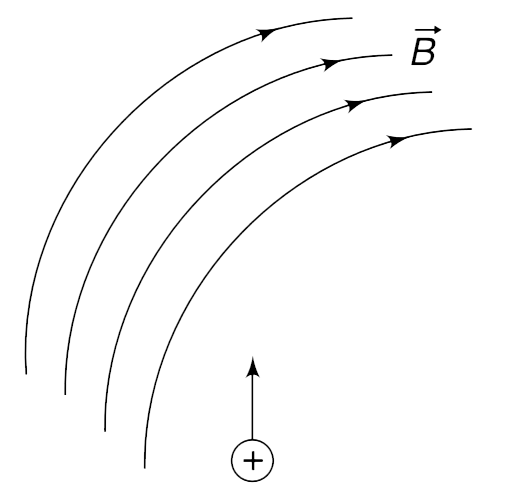Let →Eand→B denote the electric and magnetic field in a certain region of space. A proton moving with a velocity along a straight line enters the region and is found to pass through it undeflected. Indicate which of the following statement are consistent with the observation.
¯¯¯E=0 and ¯¯¯B=0
¯¯¯E≠0 and ¯¯¯B=0
→E≠0 and →B≠0 and both →E and →B are parallel to →v
→E is parallel to →v but →B is perpendicular to →v
The correct Answer is:A, B, C
→V constant in direction and may be in magnetude
→a=0
q→E+q(→V×→B)=0
Ist posibility
→E=0&→B=0→V
IInd posibility
→E=0&→V∣∣→Bi.e.→B≠0
IIIrd posibility
→E=0&→E∣∣→V&B=0
IVth posibility
→B
→V→E∣∣∣∣→V∣∣∣∣→B
→E→V×→B=0
Vth posibility
q→E=−q(→V×→B)

Topper's Solved these Questions
- BOOK - RESONANCECHAPTER - ELECTRODYNAMICSEXERCISE - Exercise-2 PART-3 COMPREHENSION-15videos
ELECTRODYNAMICS
- BOOK - RESONANCECHAPTER - ELECTRODYNAMICSEXERCISE - Exercise-2 PART-3 COMPREHENSION-23videos
ELECTRODYNAMICS
- BOOK - RESONANCECHAPTER - ELECTRODYNAMICSEXERCISE - Exercise-2 PART-226videos
ELECTRODYNAMICS
- BOOK - RESONANCECHAPTER - ELECTRO MAGNETIC WAVESEXERCISE - Exercise 327videos
ELECTRO MAGNETIC WAVES
- BOOK - RESONANCECHAPTER - ELECTROMAGNETIC INDUCTIONEXERCISE - A.l.P19videos
ELECTROMAGNETIC INDUCTION
Similar Questions
Let vecE and vecB denote electric and magnetic fields in a frame S and vecE and vecB in another frame S moving with respect to S at a velocity vecv. Two of the following equations are wrong. Identify them.
View SolutionConsider a moving charged particle in a region of magnetic field. Which of the following statements are correct?
View Solution
Knowledge Check
- Question 1 - Select One
A proton and an electron having equal velocity are allowed to pass through a uniform magnetic field. Which one of the following statements is correct in this connection?
AThe proton and the electron experience equal and opposite forceBThe proton experiences greater force then does the electronCThe electron experiences more force than does the protonDNo moving charged particle experiences a force in a magnetic field - Question 2 - Select One or More
An electron and a proton are moving on straight parallel paths with same velocity. They enter a semi infinite region of uniform magnetic field perpendicular to the velocity.
Which of the following statement(s) is /are true?AThey will never come out of the magnetic field region.BThey will come out travelling along parallel paths.CThey will come out at the same time.DThey will come out at different times. - Question 3 - Select One
Let →E, →B and →C represent the electric field, magnetic field and velocity of an electromagnetic wave respectively. Their directions, at any instant point along the unit vectors given below in order. Which of the following cannot be true?
Aˆk,ˆi, ˆjBˆk,ˆj, −ˆiCˆi, ˆj, ˆkD−ˆj, ˆk, −ˆi
If an electron is not deflected in passing through a certain region of space can we be sure that there is no magnetic field in that region?
View SolutionA wide region of space has curved magnetic field lines as shown in the figure. A proton enters into the region as shown. Draw the path of the proton.
 View Solution
View SolutionIf →E and →B represent electric and magnetic field vectors of the electromagnetic wave, the direction of propagation of electromagnetic wave is along
View SolutionIn a certain region of space electric field E and magnetic field B are perpendicular ot each other and an electron enters region perpendicular to the direction of B and E both and moves undeflected, then velocity of electron is
View SolutionIf E and B are the magnitudes of electric and magnetic field respectively in some region of space, then the possibilities for which a charged particle may move in that space with a uniform velocity of magnitude v are
View Solution

